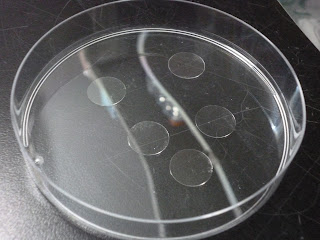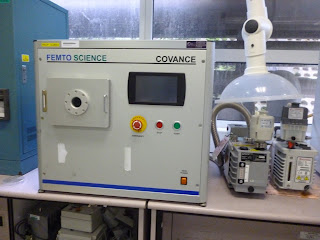PCM isn't a complex procedure. All we did was view the cells that we cultured yesterday and take a picture of it using a programme in the computer. It is a great way of storing images of cells.
The picture of the fibroblast. This is taken using a light microscope. Tomorrow we would be using an electron microscope.
We moved on to plasma treatment for polymer film.The purpose is to change the polymer film from hydrophobic to hydrophilic nature using plasma treatment. There are various ways of doing it and we are using vacuum to do this. Dr Wen Feng shared that in some cases, this process can take up half a day because there was a lot of waiting time. For example, if a different gas is used from the previous one, we would have to wait for all of the gas to be removed from the chamber.
- We picked out some pre-prepared glass slips with a thin film of polymer on it.
- We used this machine to do the plasma treatment. The mechanics are pretty complicated, something like different voltahe between the metal plates.
- Before we did the actual treatment, we did some trial runs in the plasma surface treatment machine. We first ran argon into the machine, due to the splitting of molecules, the energy used correspond to the visible light spectrum and a pretty pink colour was observed in the vacuum container. Then the argon gas was removed using a vacuum and replaced with oxygen gas. A white colour was observed instead. Some bits of pink can still be observed because some argon gas is left.
- For the actual runs, we placed the glass slips into the vacuum container, ran argon into it for about a minute. Although it is supposed to be pink, it looks a bit purple-ish. This is because not all the oxygen gas was removed from the trial runs. A layer (not really visible) of plasma was formed.
- We tested the nature by placing a drop of water on it and the water would spread out. The control cover slips reamined hydrophobic and the same drop of water did not spread out. Hence, this proves that the nature of cover slips was changed from hydrophobic to hydrophilic.
- To have a more accurate result, we could do a WCA test to test the angle of the water on the surface. A smaller angle would mean more hydrophilic as the water would spread. Although we didn't get to do the test, we observed someone else doing it.
Glass cover slips with a thin layer of polymer. We had fun taking them out. HEHE
Plasma surface treatment machine
The different gases used for the plasma treatment. We are using argon gas and oxygen gas.
Before
After argon gas is added
After oxygen gas is added
We used argon in the actual treatment. It looks a little purple-ish though.
Testing the nature of the cover slips with a drop of deionised water.
The control remains hydrophobic.
After treatment, it becomes hydrophilic. (The drop of water spreads out!)
This is actually a product video, it doesn't show the full process. But it shows the before and after of this procedure. Start from 0:11.
This is the WCA test.
(We saw test tubes with the hearts of the rats.... We are not going to post pictures.)
A lot of things need to be put on.
Lab rats.
After lunch, we came back to start on the preparation for the scanning electron microscope (SEM) we are going to use tomorrow.
- After removing the culture medium from the culture plate we incubated earlier, we washed it with PBS.
- 2.5% glutaraldehyde (GA) is added to fix the cells and left for an hour in room temperature. Actually, if you realised, we have used a variety of different chemicals for cell fixation. Ajay used paraformaldehyde with triton, while Ivan used ethanol. GA is also another chemical we can use for cell fixation.
- Ethanol of increasing concentration is added with 10mins intervals. After 10mins, the previous ethanol solution is removed and replaced with another ethanol solution of increasing concentration. 50% ethanol is added first, followed by 70%, 95% and 100%. Ethanol is used to dehydrate the cells by slowly removing the water in the cells on the scaffolds.
- MDS is added to replace the ethanol solution in the cells as ethanol can damage the cell surface membrane. A better alternative would be to use liquid carbon dioxide because MDS can also slight harm to the cells as well. However, we don't have it in the lab.
- The cells and the scaffolds are incubated overnight at 37 degrees C.
Varying concentrations of ethanol
Dr Wen Feng allowed us to prepare the ethanol solutions ourselves!
Lucky Alethea also got the add the ethanol to the cells as well.
We learnt a lot from Dr Wen Feng! Thank you very much!































No comments:
Post a Comment